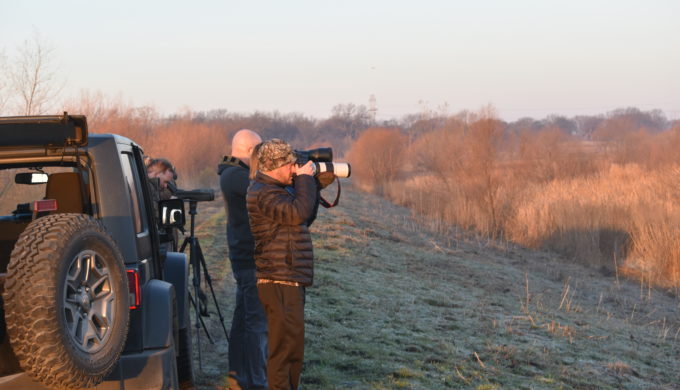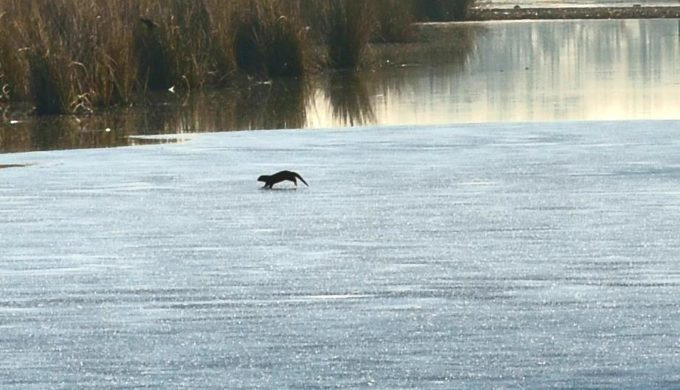As I approach the East Fork Wetland Project this winter morning, a pink-orange glow from the sky begins to reflect off the water. The full moon still shines on the ice edging the pools. I climb into a Jeep with several avid birders, and we are off on a four-hour tour into the nonpublic areas of the wetland.
“I think I see a cinnamon teal,” exclaims my friend in the back seat, as we stop on one of the levees separating the cells (pools) of water. The driver asks, “Is that a life bird for you?” and the passenger nods, meaning it’s the first time he’s seen that variety of duck. I’m clearly out of my league when it comes to birding, but it doesn’t matter now as we bounce along the rise of the levees, all of us watching diligently for the familiar as well as less common fowl.
Photo: John Spaulding. Early morning birders aim their lenses to spot rare and familiar birds.
Comprising over 1,800 acres, one of the largest manmade wetlands in the country began from the death of a dream. The John Bunker Sands Wetland Center opened to visitors in 2010, named for the man who, in 1980, originally imagined a manmade wetland near the east fork of the Trinity River. John Bunker Sands, the son of philanthropists Caroline Rose Hunt and Loyd Bowmer Sands, served as Executive Director of Ranch Management of the family-run Rosewood Corporation. He became increasingly dedicated to reestablishing the bottomland environment that had flourished over 200 years ago. To determine the project’s feasibility, he contracted with an environmental design and construction company. The design was completed, but it had to be shelved when the U.S. Army Corps of Engineers raised concerns about breaching the 1940s-era levees. Not only did his wetland idea die, but Sands would not live to see the transformation he had envisioned. He passed away in 2003.
However, not long after Sands’ death, the need for an additional water source brought the idea back to life. The North Texas Municipal Water District (NTMWD) coincidentally contracted with the same environmental design company used by Sands years earlier. And the land? An NTMWD board member knew just the right fit—the land along the east fork of the Trinity, owned by the Rosewood Corporation. The new design, including the pumping system, meant the levees would not need to be breached.
Photo: John Spaulding. Look up! Skies filled with migrating snow geese are a welcome and healthy sign.
Today, the Wetland Project includes over 20 species and 1.6 million individual plants, carefully selected to clean the water. More than 260 species of birds and a variety of wildlife have come to call this area home, or at least a stop on their migratory journey.
As we come upon one of the recently drained cells of water, a flock of snow geese searches for tasty morsels in the rich residue of silt and mud. While my bird-watching friends take photos of the feeding birds, I turn to the other side of the levee, where ice has formed over part of the adjacent cells. In the distance, a long-tailed critter skates across the pond. Perhaps it’s a nutria, I think, but snap a photo anyway. Later, Linda Dunn, the Wetland Center’s Education Manager, says, “What you’ve captured in that picture is a river otter; in the seven years I’ve been here, I’ve never seen one. We knew they were here—and that’s a sign of a healthy wetland—but they’re very camera shy.”
Photo: John Spaulding. A rarely seen river otter skitters across the ice.
When it comes to wildlife watching, anyone can view the star attraction—a nesting pair of bald eagles who have made their 200-lb. nest in one of the outstretched arms of an electric transmission tower. For the safety of the eagles, and reliable power delivery, four years ago, the power company moved the entire cross arm to a new nearby tower. This has resulted in several eggs and fledglings, with the parents returning year after year. Eagle fans can view the celebrity pair thanks to a solar-powered Live Eagle Camera (when the weather and technology cooperate) on the John Bunker Sands Wetland Center’s website. For more impatient eagle-watchers, a YouTube link provides a view of a previous hatching.
Photo: John Spaulding. Just above the top of the electric tower arm, eagle parents watch over their nest.
The East Fork Wetland Project’s original purpose was for the plants to naturally cleanse the extra nitrogen, phosphates, and ammonia from the river water, which is pumped back to Lake Lavon and used by multiple towns that depend on clean water from the NTMWD. The plants, such as pickerelweed, eelgrass, and bulrush, are specifically purposed for this. Four categories of plants (shoreline, emergent, floating, and submerged) thrive in a series of cells separated by levees and controlled by weirs (gates) that regulate the flow and depth of the water. Signs along the three-foot-wide boardwalk running through the cell closest to the Wetland Center describe the plants in greater detail, including the children’s rhyme: “Sedges have edges, Rushes are round, Grasses are hollow, what have you found?”
It’s hard to limit what we find to just one aspect of the Wetland Center; plants, reptiles, animals, birds, and technology all play a part in a healthy ecosystem, providing clean water to more than a dozen communities in North Texas. Executive Director John DeFillipo agrees. “To see this place change from a pasture to an emergent wetland to a matured wetland in about eight years has been phenomenal.”
And here comes the next generation of Wetland Project enthusiasts, both elementary and high school students that the Wetland Center is welcoming by the hundreds. Volunteers and area schools participate in educational programming and research opportunities that further the Center’s mission. A regular school field trip may blossom into a field ecology experience, transforming young minds and even career goals. “The children walk out on the boardwalk and their eyes open up,” DeFillipo says. “They look around, and then they slow down—and that connects them directly with the environment. They write me letters exclaiming ‘I didn’t know this was here!’ or ‘You get paid for this?’” as they learn about careers in environmental science.” DeFillipo adds, “My big dream is that a student would come through these doors and leave thinking, ‘I can do that,’ whether it’s a career or finding a solution to our future water needs.”
Photo: John Spaulding.
The foresight of the Sands family combined with public and private partnerships have made the Wetland Project a success, DeFillipo says. The center provides tours, nature classes, and a relaxing deck/patio complete with rocking chairs for guests to view wildlife. The boardwalk is another way to watch the Wetland Center activity, as it extends into one of the cells. The Wetland Center is open every first Saturday of the month from 7 a.m. to 4 p.m. and third Saturday from 9 a.m. to 4 p.m., and also for special events. Major gatherings and fundraisers include “Wings Over the Wetlands” every other October, and an upcoming May 11 “Mudbug Festival” and fun run, offering a crawfish feast and fun for the entire family.
The Wetland Project is the story of human ingenuity meeting the natural world, creating a place where both can thrive. Many birds I viewed on this chilly morning were “life birds” for me, but my visit was also a life experience that will bring me back season after season. Visit their website: www.wetlandcenter.com








